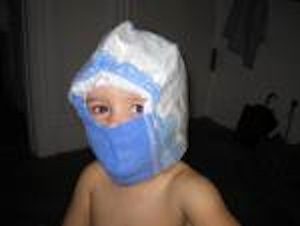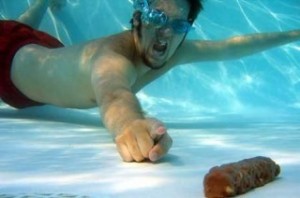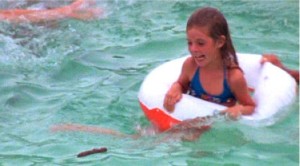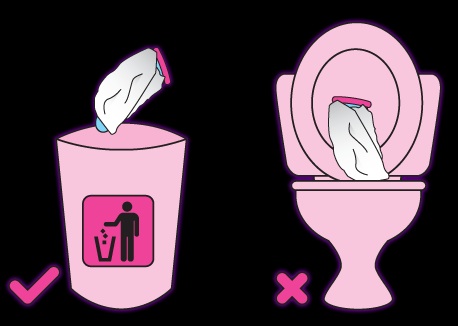It matters what’s done after people barf. Same if people have diarrhea – in a pool.
During the summer of 2007, almost 6,000 people in Utah started barfing from Cryptosporidium, transmitted via the barfblog fav, fecal-oral route
The U.S. Centers for Disease Control reports that of 1,506 interviewed patients with laboratory-confirmed cryptosporidiosis, 1,209 (80%) reported swimming in at least one of approximately 450 recreational water venues during their potential 14-day incubation period.
Cryptosporidium is extremely chlorine-tolerant, and secondary or supplemental disinfection with ultraviolet light or ozone can control but not prevent outbreaks. Because swimmers are the primary source of Cryptosporidium contamination, healthy swimming campaigns are needed to increase awareness and practice of healthy swimming behaviors, especially not swimming while .jpg) ill with diarrhea (i.e., swimming while ill with diarrhea can lead to gross contamination of recreational water). Before the 2008 summer swimming season, Utah public health agencies launched a multimedia healthy swimming campaign. To assess knowledge of healthy swimming, a survey of Utah residents was conducted during July–September 2008. The results of that survey found that 96.1% of respondents correctly indicated that "it is not OK to swim if you have diarrhea."
ill with diarrhea (i.e., swimming while ill with diarrhea can lead to gross contamination of recreational water). Before the 2008 summer swimming season, Utah public health agencies launched a multimedia healthy swimming campaign. To assess knowledge of healthy swimming, a survey of Utah residents was conducted during July–September 2008. The results of that survey found that 96.1% of respondents correctly indicated that "it is not OK to swim if you have diarrhea."
In a separate national survey in 2009, 100% of Utah residents but only 78.4% of residents of other states correctly indicated that "not swimming while ill with diarrhea protects others from recreational water illnesses (RWIs)." No recreational water–associated outbreaks were detected in Utah during 2008–2011. The healthy swimming campaign, as part of a multipronged prevention effort, might have helped prevent recreational water–associated outbreaks of cryptosporidiosis in Utah.
Before the 2008 summer swimming season, Utah’s state and local public health agencies teamed with community partners to control recreational water–associated transmission of Cryptosporidium. For example, the Salt Lake Valley Health Department (SLVHD) collaborated with pool operators to establish fecal incident–response protocols and install secondary or supplement disinfection systems to inactivate Cryptosporidium at 75 treated recreational water venues.
SLVHD also collaborated with the Utah Department of Health and diagnostic laboratories to expedite reporting of cryptosporidiosis cases to public health authorities. To engage the public in prevention, SLVHD led efforts to disseminate healthy swimming messages via a website, two .jpg) television advertisements, public service radio announcements, and posters at pools (e.g., "A Swimming Pool is Like a Community Bathtub"). In addition, targeted messages were disseminated to schools, competitive water sports teams, and licensed childcare facilities. SLVHD also conducted a press conference during Recreational Water Illness and Injury Prevention Week, which is held each year the week before the Memorial Day holiday.
television advertisements, public service radio announcements, and posters at pools (e.g., "A Swimming Pool is Like a Community Bathtub"). In addition, targeted messages were disseminated to schools, competitive water sports teams, and licensed childcare facilities. SLVHD also conducted a press conference during Recreational Water Illness and Injury Prevention Week, which is held each year the week before the Memorial Day holiday.
The complete report is available at http://www.cdc.gov/mmwr/preview/mmwrhtml/mm6119a5.htm?s_cid=mm6119a5_x.
 I was one of them one of them.
I was one of them one of them.




 democratization of information: the accurate, to-the-point reporting conducted by academic scholars, which is accessible to the general public via social media. He reiterates that social media is great for quick, accessible information, but the traditional form of reporting is not outdated and remains very practical for in-depth research. Thus the two forms of communication are complementary, each supporting the other in order to supplement the academic community with reliable, up-to-date information.”
democratization of information: the accurate, to-the-point reporting conducted by academic scholars, which is accessible to the general public via social media. He reiterates that social media is great for quick, accessible information, but the traditional form of reporting is not outdated and remains very practical for in-depth research. Thus the two forms of communication are complementary, each supporting the other in order to supplement the academic community with reliable, up-to-date information.”.jpg) ill with diarrhea (i.e., swimming while ill with diarrhea can lead to gross contamination of recreational water). Before the 2008 summer swimming season, Utah public health agencies launched a multimedia healthy swimming campaign. To assess knowledge of healthy swimming, a survey of Utah residents was conducted during July–September 2008. The results of that survey found that 96.1% of respondents correctly indicated that "it is not OK to swim if you have diarrhea."
ill with diarrhea (i.e., swimming while ill with diarrhea can lead to gross contamination of recreational water). Before the 2008 summer swimming season, Utah public health agencies launched a multimedia healthy swimming campaign. To assess knowledge of healthy swimming, a survey of Utah residents was conducted during July–September 2008. The results of that survey found that 96.1% of respondents correctly indicated that "it is not OK to swim if you have diarrhea." .jpg) television advertisements, public service radio announcements, and posters at pools (e.g., "A Swimming Pool is Like a Community Bathtub"). In addition, targeted messages were disseminated to schools, competitive water sports teams, and licensed childcare facilities. SLVHD also conducted a press conference during Recreational Water Illness and Injury Prevention Week, which is held each year the week before the Memorial Day holiday.
television advertisements, public service radio announcements, and posters at pools (e.g., "A Swimming Pool is Like a Community Bathtub"). In addition, targeted messages were disseminated to schools, competitive water sports teams, and licensed childcare facilities. SLVHD also conducted a press conference during Recreational Water Illness and Injury Prevention Week, which is held each year the week before the Memorial Day holiday..jpg) pool. It got into the filtration system and they charged us to clean it. That was expensive. He took a $6,000 dump in the pool!”
pool. It got into the filtration system and they charged us to clean it. That was expensive. He took a $6,000 dump in the pool!” swimming pool.
swimming pool..jpg) the time."
the time." of sick British swimmers has now risen to 40
of sick British swimmers has now risen to 40 "I am not quite sure what the point is, if that is happening it shows that there is use of condoms and I think that is a very positive story, that athletes are being responsible."
"I am not quite sure what the point is, if that is happening it shows that there is use of condoms and I think that is a very positive story, that athletes are being responsible." Chevy Chase explains to Danny how the universe works and “to be the ball.”
Chevy Chase explains to Danny how the universe works and “to be the ball.”